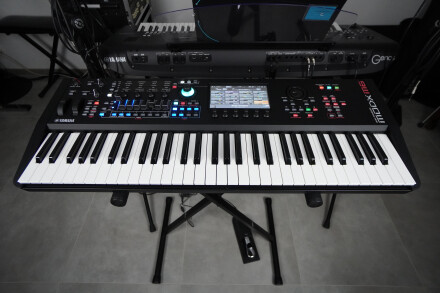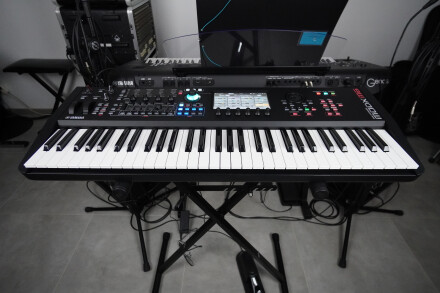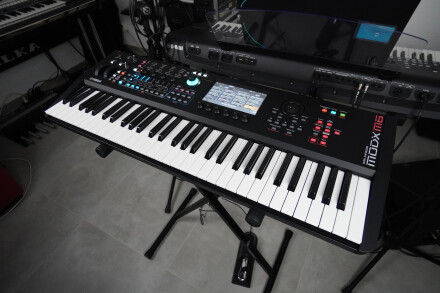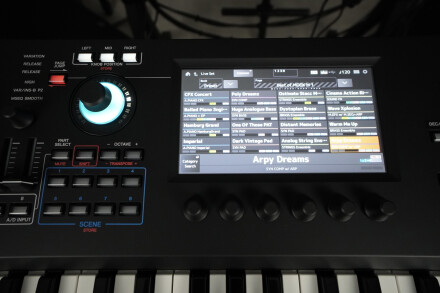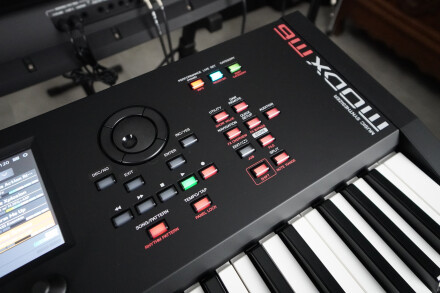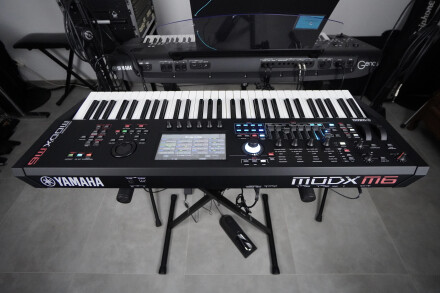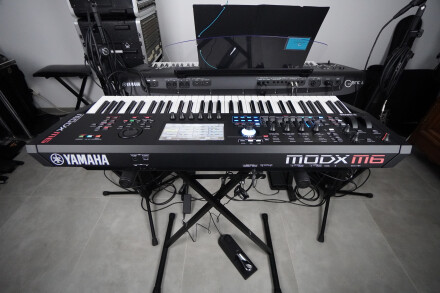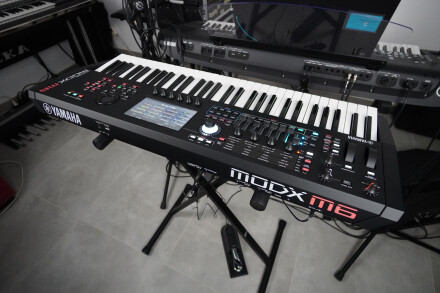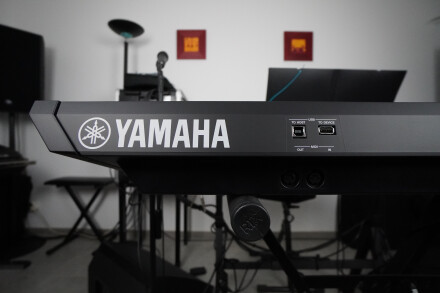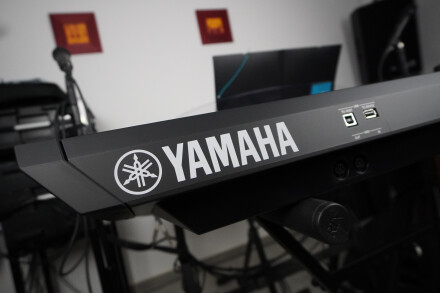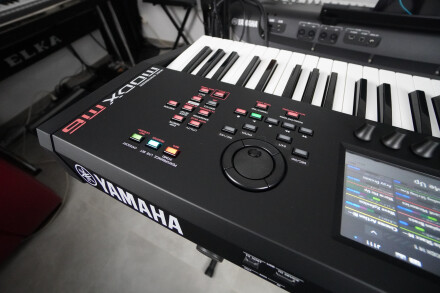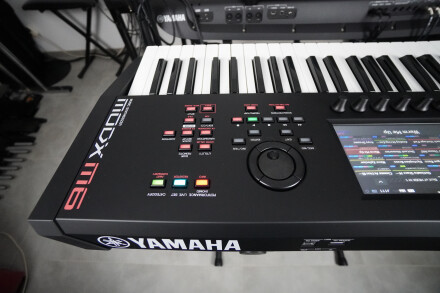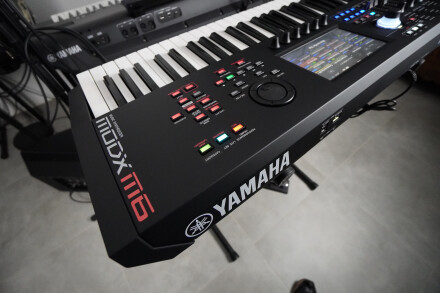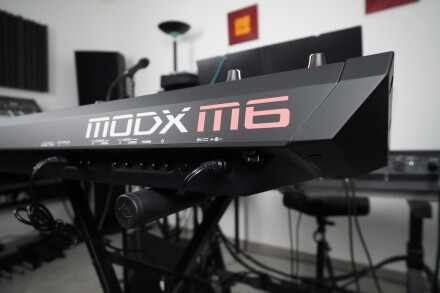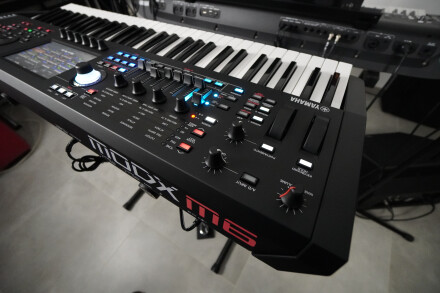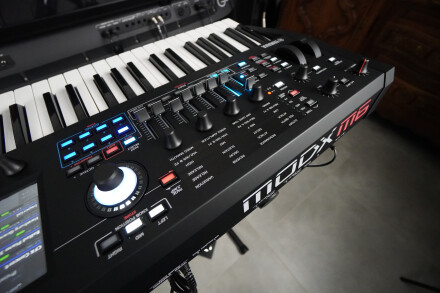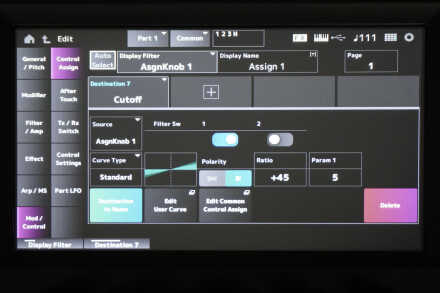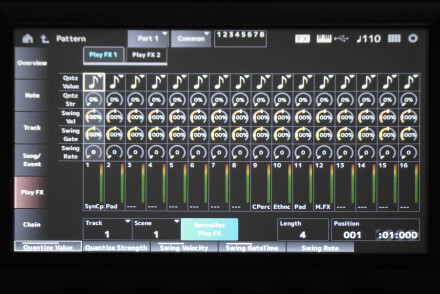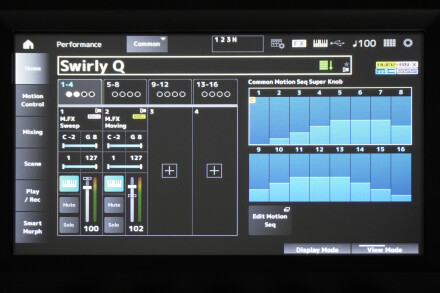After the Montage M series was released at the end of 2023 through selected distributors, here comes a very affordable variation of Yamaha's big synth/workstation. Has the new MODX M retained most of its big brother's strengths?

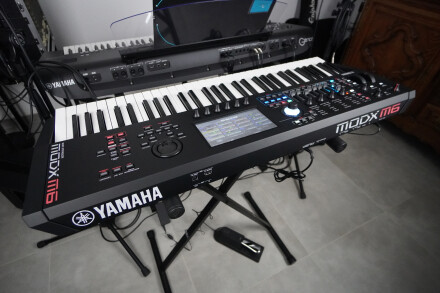
At the end of 2023, Yamaha unveiled a significant evolution of its flagship Montage M series, featuring a new AN-X analog-modeling synthesis engine based on technology developed for the AN1x in 1997, and a redesigned ergonomic design. As the manufacturer has opted for selective distribution, we were unable to procure a review unit. Since then, the Montage M has evolved into the V3 system, featuring new sounds and functions.
Two years later, a more affordable version was released, logically named MODX M. Despite selective distribution, apparently more extensive than for the Montage M, we were able to borrow a review unit from Yamaha, thank you. Let’s see what the little newcomer has retained from the big brother to make a workstation (or a supercharged synth) that’s as attractive as it is affordable.
A lighter package with rigid plastic materials and an improved keyboard
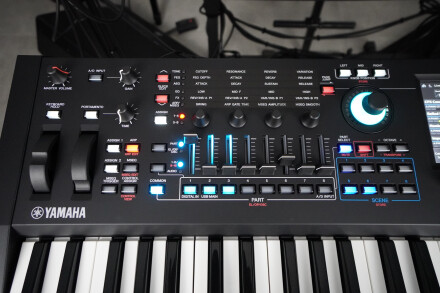
The keyboards respond to velocity, but not to pressure (polyphonic pressure is recognized in reception). On our review unit, we immediately noticed clear improvement in the keyboard, with better response, greater resistance and less noise than its counterpart on the MODX 6. That’s excellent news, even if this new keyboard doesn’t match the quality of the FSX fitted to the brand’s top-of-the-range models.

Additionally, there are eight backlit mixing sliders, a multicolor Super Knob for complex macro-modulations (more on this later), eight scene keys, two transposition keys (by octave or semitone), an encoder surrounded by four navigation arrows coupled with four yes/no/enter/exit keys, full sequencer transport controls, program mode selection keys (performance, scene lists, category) and various function keys (utility, navigation, editing, quick settings, DAW control, quick split four zones). What’s missing compared to the Montage M is the direct category-selection pad on the right side of the panel.
A large TFT screen with neat graphics that make editing easy

In addition, Yamaha equipped certain keys with rainbow LEDs, making it easy to discern status or the current editing mode. They’ve even included two Shift keys on either side of the panel, a good idea that allows you to access secondary functions while playing with the hand of your choice without contorting your body. In short, enough to quickly build up multitimbral performances with arpeggios, sequences and various direct controls.

Additionally, there are two switch pedal inputs (one of which is hold), two assignable continuous pedal inputs, two MIDI DIN jacks (Thru switchable input + output, with MIDI 2.0 high resolution on keyboard velocity, knobs and Super Knob), two USB sockets (type A and B for connecting a PC, keyboard controller or backup unit) and a terminal for the external power supply of the central block type (much better than a wall-mounted power supply).
A powerful synth calling on three sound engines over 16 multitimbral channels, with a soon-to-be-integrated software version
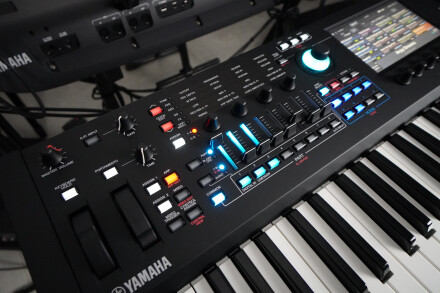
Each channel has its own settings for volume, panning, insert effects A and B (limited to 13 units in total — eight for channels 1–8, four to be shared between channels 9–16, and one for audio input), sends to the two master effects, note range, velocity window, audio output (analog or USB mono/stereo), play mode (mono/poly), pitch, portamento, microtonal range, keyboard zone (internal or external control on eight simultaneous channels) and everything that moves (arpeggios, motion sequences, modulations).
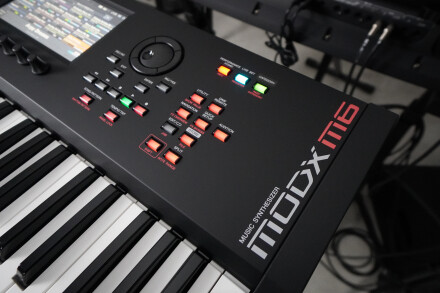
A handy quick-edit function lets you modify dozens of parameters, linked to one or more sound parts, on a single screen. Internal parameters are quantified at high resolution — precision enthusiasts will appreciate this. Finally, it’s worth mentioning that lucky MODX M owners will be able to download the ESP plug-in free of charge from 2026, a complete synth model for host DAWs, with no need for the hardware version, ensuring total continuity, whatever the working environment. Already, the MODX M provides access to a free download of Cubase AI, to complement its internal sequencer.
A large sound panoply and good quality audio output mixing samples fm and analog modeling
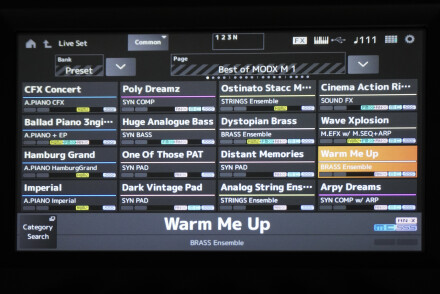
MODX M comes with 3,427 Performances and 256 Live Sets (favorites), most of them taken from the Montage M bank, with which it is fully compatible. In addition, it can store 640 Performances and 2,048 Live Sets (and as many in each of the 24 User Libraries), so there’s plenty to look forward to. These include acoustic pianos (CFX, CFX2, C7, Steinway D, Bösendorfer Imperial…), electric pianos (CP80, various Rhodes, Wurlitzer, Clavinet — including YC sounds), organs (B3, Farfisa, Vox, pipe), guitars (nylon, metal, electric), strings (ensembles of various sizes, solo), wind instruments, choirs and percussion kits (so everything!).
These sounds benefit from numerous articulations to enhance rendering, and in our opinion, this is the most homogeneous and musical multisample bank on the market for a hardware synth. Of course, it doesn’t reach the level of specialized DAWs, but how much power and budget does it take to send 16 channels without flinching after 20 seconds of boot-up? Not to mention the other synthesis engines we’ll talk about later.
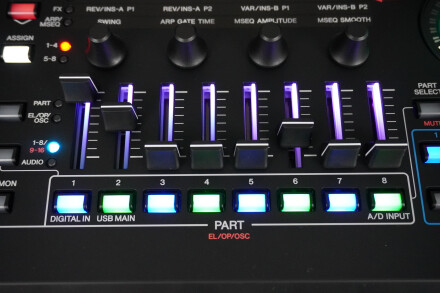
The new AN-X engine delivers powerful, punchy, all-purpose sounds. The sound temperature is very neutral (neither hot nor cold). The rendering doesn’t match the specific vintage synth modeling found in some competitors, which, in our opinion, has more character and realism. Beyond the sound, it lacks the dedicated controls of a subtractive synth, making it harder to get straight to the point. Be that as it may, the three engines blend and complement each other wonderfully, one of the MODX M’s indisputable strengths, to which are added its extensive manual and automatic modulation possibilities. It excels in complex evolving textures, driven by physical controllers or motion sequences. Add to this the power and musicality of the integrated effects section (including superb vintage effects modeling and a bewitching new Shimmer). Performance changes are seamless (SSS) as long as they are limited to six parts (compared to eight for the Montage M). Very big sound!

- MODX M_01audio 01 Comp100:42
- MODX M_01audio 02 Comp200:42
- MODX M_01audio 03 Comp300:56
- MODX M_01audio 04 Comp400:37
- MODX M_01audio 05 Comp500:13
- MODX M_01audio 06 Comp600:33
- MODX M_01audio 07 Comp700:14
- MODX M_01audio 08 Comp800:32
- MODX M_01audio 09 Comp900:29
- MODX M_01audio 10 Comp1000:50
- MODX M_01audio 11 Synth100:37
- MODX M_01audio 12 Synth200:49
- MODX M_01audio 13 Synth300:24
- MODX M_01audio 14 ANX100:49
- MODX M_01audio 15 ANX200:20
- MODX M_01audio 16 ANX300:21
- MODX M_01audio 17 ANX400:49
- MODX M_01audio 18 CFX100:23
- MODX M_01audio 19 CFX200:31
- MODX M_01audio 20 Imperial00:33
- MODX M_01audio 21 Steinway00:33
- MODX M_01audio 22 CP8000:33
- MODX M_01audio 23 Road100:33
- MODX M_01audio 24 Road200:31
- MODX M_01audio 25 Wurly00:32
- MODX M_01audio 26 TW100:25
- MODX M_01audio 27 TW200:39
- MODX M_01audio 28 TW300:21
- MODX M_01audio 29 AGuit00:25
- MODX M_01audio 30 EGuit00:33
- MODX M_01audio 31 Ens Strings00:33
- MODX M_01audio 32 Chamb Strings00:19
- MODX M_01audio 33 Section Strings00:34
- MODX M_01audio 34 Choir Organ00:44
A first sound engine made up of multisamples AWM2…
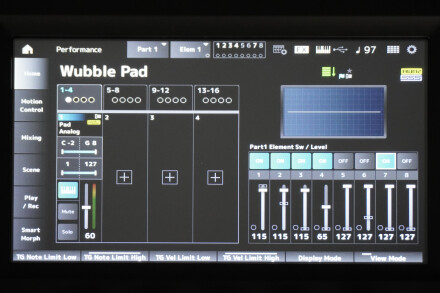
Let’s move on to synthesis: an AWM2 part can contain a multisample (Normal type) or a percussion kit (Drum type). The Normal type offers up to 128 simultaneous sound elements. This number may seem insignificant, but it eliminates a well-known constraint for MODX users limited to eight elements: the need to use several channels of a Performance for sounds that stack many layers of samples (for example, certain grand pianos and string ensembles). As a result, when you want to assemble several complex sounds, you quickly consume channels. On the MODX M, even a very complex AWM2 sound occupies just one channel.
Each element consists of a stereo multisample -> filter -> amp, with associated modulations (detailed later). We start by choosing the multisample (internal or imported), its range, velocity window, playing articulation (legato, staccato, cycle, random, release effect) to make real instruments more real, its tuning and its routing to the two insert effects. Pitch is modulated by velocity, a random generator, keyboard tracking and a 5-time/5-level envelope, itself modulated by velocity (time and levels) and keyboard tracking (time). You can go down to the level of the multisample zones (Key Bank) and redefine their range and velocity, which is great fun!

We continue with the amp part, featuring a dedicated 4-time/4-level envelope, a 4-point tracking generator, pan modulation (keyboard tracking, random), and a Half Damper mode (with Decay time, useful for simulating an acoustic piano pedal with a compatible pedal, such as the FC3). Still at the element level, there’s an LFO with three basic waveforms (sawtooth, triangle, square) that can affect pitch, filter, and amp, followed by a simplified EQ bands, one parametric band, (two semi-parametric or +6/+12/+18 dB boost). All that for one element!
Let’s move on to the Drum type: this allows you to define separate parameters for the 73 assignable keys, and thus create a drum kit: choice of sample, audio output (analog, USB), range, velocity, pitch (modulated by velocity), trigger mode (exclusive, note off, hold), assignment to the two insert effects, starting levels to the two global effects, filter cutoff, etc; global effects, low-pass filter cutoff (modulated by velocity), resonance, high-pass filter cutoff, volume (modulated by velocity and a 3 time/1-level envelope), panning (fixed, auto sweep, random) and EQ. Alas, there’s no access to the different layers of samples sometimes present on the same note. It’s also a pity that drum kit sounds are limited to the AWM2 engine; it would have been nice to be able to assign FM-X or AN-X sounds.. To avoid starting from scratch, the MODX M features 152 pre-programmed kits in various styles (Pop, rock, jazz, Latin, EDM, classical, ethnic, FX).
A second FM-X sound engine based on FM synthesis with eight operators
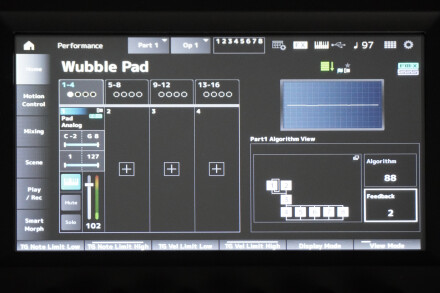
FM can be performed according to a frequency ratio or a fixed frequency over the entire range (creation of formants). MODX M contains 88 algorithms with eight operators. The algorithm defines the nature and interaction of the operators. Thus, we can have eight carriers added side by side, carriers modulated by several separate branches of modulators, and carriers modulated by one to four modulators in cascade. Some operators can self-modulate, alone or in combination (feedback). This feature enables complex spectra to be created from basic cyclic waves. On the MODX M, there are several possible waves for each operator, which go much further than early FM synths like the DX7, confined to sine waves.

We then move on to the operator’s level parameters: initial level, velocity on level, 4-time/4-level envelope, keyboard tracking (time, levels, curves, center point). Remember that a level corresponds to volume on a carrier operator and to modulation intensity (timbre) on a modulator operator. The ergonomics of the FM editor are always appreciated, whether for algorithm selection or envelope curves. It almost makes you want to dive in!
A third analog-modeled AN-X sound engine based on three oscillators, a waveformer and two filters

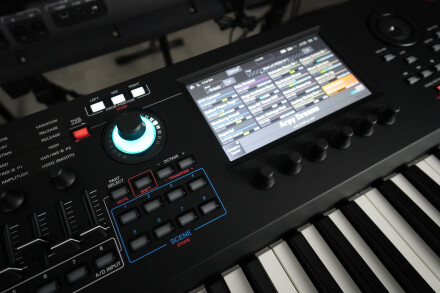
There are three oscillators, offering sawtooth, saturated sawtooth, square, triangle and sine waves, all with PWM and inversion settings. Each oscillator offers a virtual oscillator for cycle sync, which is a nice touch. Oscillator 3 can modulate oscillators 1 and 2 in FM and ring. There’s also a variable color noise. The volume of these four sources can be metered, and each can bypass the filters.
A Wave Folder folds the wave spectrum into different intensities and colors, creating new harmonic content or a certain saturation, more or less aggressive. Then there are two multimode filters in series (low-pass 1–2–3–4 poles, high-pass 1–2–3–4 poles, band-pass 1–2 poles) with saturation settings. They cannot self-oscillate. Finally, a final amp lets you adjust volume and add an extra drive. As for modulations, there are envelopes, LFOs and velocity settings at almost every level (oscillator frequencies, PW, volumes, wave distorter, filter cutoff frequency, resonance, final volume), impossible to fully list here. And let’s not forget the matrix modulations per part, which we’ll talk about next, as they are the same for all synthesis engines, apart from the specific destinations for each engine. For the FM-X and AN-X engines, a Smart Morph function lets you create a new program in a matter of seconds by interpolating eight others from the same engine, all at the touch of a fingertip — nice.
Beautiful modulation possibilities, whether with dedicated physical controllers or programmed sources
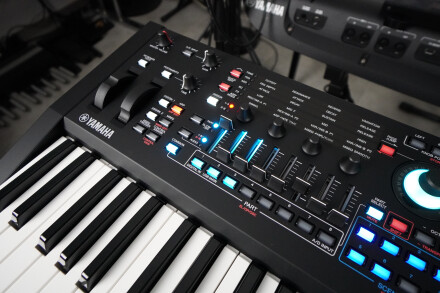
It can control the movements of eight encoders assigned to destinations such as synthesis or effects parameters. For each encoder, mini/central/maxi values are set, representing the range of action to be controlled by the Super Knob. Turning the Super Knob causes the encoders to act between any values and in any direction. The action of the Super Knob can be controlled by a modulation pedal (type FC7), keeping both hands free, which is a good idea for those who play the keyboard with more than one finger. It can even be assigned a MIDI CC or controlled via the motion sequencer. Buttons on the front panel let you immediately set the Super Knob to mini, center and maxi positions.

In each step, you define a modulation quantity (mono or bipolar) and a curve (various editable types, from smooth to highly chaotic). For the line, you can set playback speed, tempo synchronization, note synchronization, length, looping, activation velocity window, global smoothing between steps, etc. MODX M offers 24 modulation sequence presets and 256 user memories. In master keyboard mode, you can have eight sequences of movements running at the same time, which is huge!
Still on the subject of complex modulations, the modulation matrix has 32 cords per sound part. There are some forty sources at your disposal: knobs, pressure (incoming), virtual ribbon, switches, pedals, encoders, four motion sequencer lines, 18 envelope followers (16 sound parts, A/D part, Master. Modulation quantity is a curve parameterizable in input, output, polarity, and profile. Destinations are either common to each part or targeted to different elements/operators/modules within a part. There are over a hundred of them, including synthesis parameters, parameters for the two insertion effects and three global effects, sends to the first two global effects, assignable encoders. In short, it’s heavy stuff! The envelope follower transforms an audio signal into a control signal, with automatic synchronization to the audio present at the A/D input. To create this signal, you can choose between different sources: the output of one of the 16 sound parts of a Performance, the entire Performance or the audio input. The signal created then becomes a modulation source in its own right.
A powerful multieffects section available on multiple channels
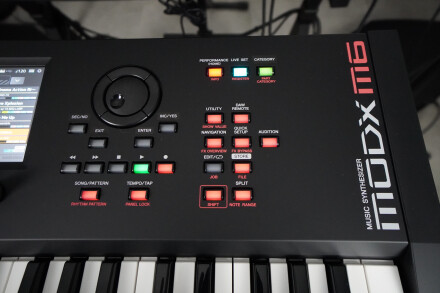
Insert effects are, in fact, powerful multieffects comprising 88 complex algorithms (up to 24 parameters) that can be modulated in real time: reverbs, delays, ensembles, compressors, amp simulators, distortions, EQ, signal destructors, beat effects and cascade effects. Insert effects (A, B) can be placed in series (A -> B or B -> A) or in parallel. Each element of a sound section can be connected to them. Some algorithms feature a Side Chain (from a part from 1 to 16, from the master or external audio input): 376 compressor, classic compressor, multiband compressor, classic ring modulator, dynamic ring modulator, dynamic filter, dynamic phaser, dynamic flanger. A vocoder effect enables internal sounds (carriers) to be processed via the audio line/mic inputs (modulator); 10 bands are available, with compression/Gate at input, formant offset, noise, HPF and separate gains for the bands. To save us time, Yamaha has provided each effect with a number of ready-to-use presets, which is an excellent idea!

At the end of the chain is a final 5-band EQ (Peaking / Shelving for the center bands, Shelving for the extreme bands). But that’s not all, as the MODX M is equipped with an ultra-sophisticated VCM rotary speaker model, available only on the first channel of the Performance. This effect, highly polished and highly parameterizable, goes far beyond the rotating-speaker effects otherwise available on the synth. It is available in three models: classic, with transistor overdrive and 3D. That makes a total of several dozen multieffects, with new algorithms compared to the MODX, and the quality is top-level!
A big arpeggiator allied to an always-basic MIDI sequencer
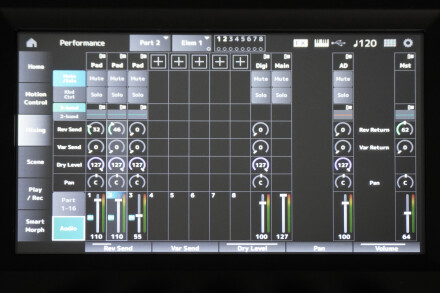
The many playback parameters include note order, looping, quantization, range, octave transposition (-3 to +3) and random effects (noise triggering, e.g., guitar frets). MODX M is also capable of creating 256 user arpeggios and extracting them from a Song part. You define the Song portion to be exported, the type of notes to be generated (tracking, fixed, tracking the original note) and the destination tracks in the arpeggio. Inherited from MODX, a button gives direct access to a rhythm track, consisting of a kit selected from the machine’s memory and a pattern drawn from the drum arpeggios. This track is assigned to one of the first eight channels; in conjunction with the envelope follower, this makes it possible to create rhythmic pumping effects.

It’s impossible to precisely edit any track once it’s been recorded; all you can do is undo the last take. This limits the sequencer to the reproduction of preset tracks or a notepad for immortalizing ideas, and deprives the MODX M of workstation status; fortunately, you can export a track to a PC, edit it (for example, in the Cubase AI supplied) and then import it back into the MODX M in SMF 0 or 1 format. Finally, MODX M lets you record up to 74 minutes of fixed-level 24-bit/44 kHz stereo audio onto a USB stick. It can also play 16–24 bit/44 kHz audio files from the same key. Always useful!
Advanced keyboard capabilities to drive internal sounds and external-devices

In general, the first eight channels are used to drive internal or external sounds with the keyboard, and the next eight to drive the synth from the outside. Each part can have its own MIDI channel, so there are no constraints. Settings are saved in Performances. The MODX M can also control the main DAWs on the market from its front panel and display.
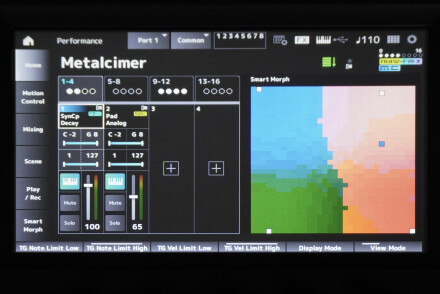
Finally, as far as sound banks are concerned, MODX M is fully compatible with Montage M, as already mentioned, but also with the Motif series for the AWM2 engine. As for the FM-X engine, it can be fed with DX7/DX7II/TX802/TX816 banks after conversion. In short, the MODX M is not only virtually autonomous, but it also interfaces very well with the outside world.


